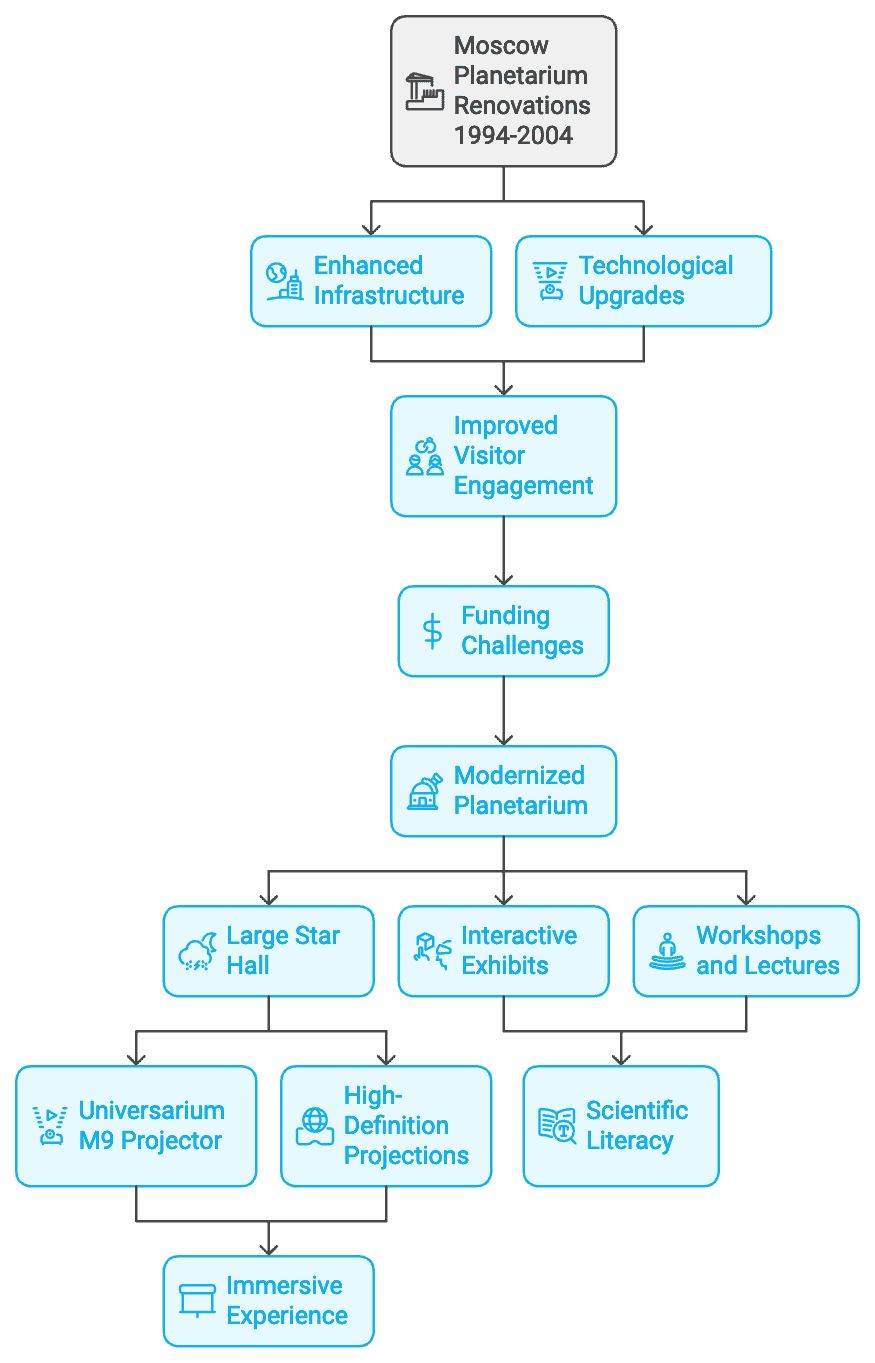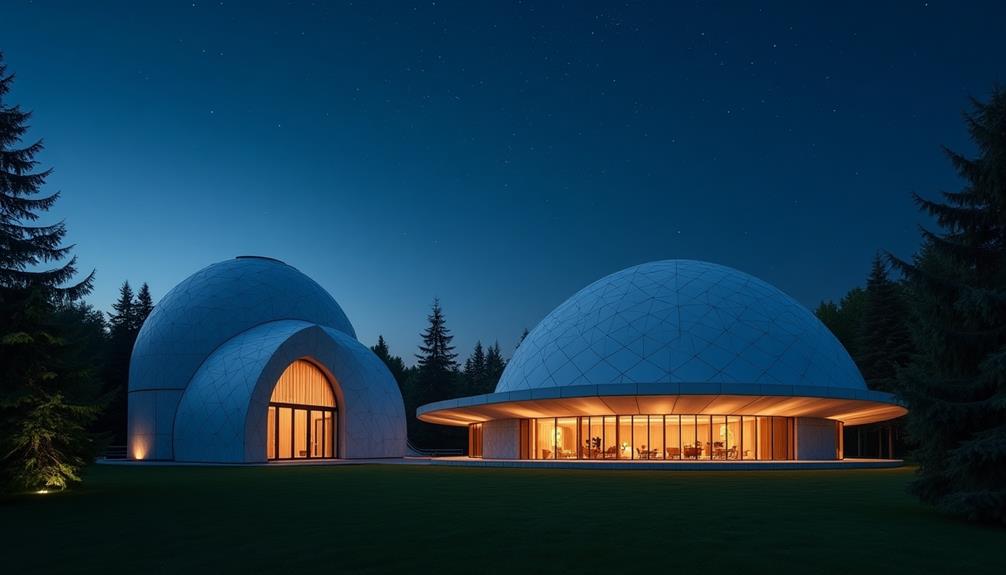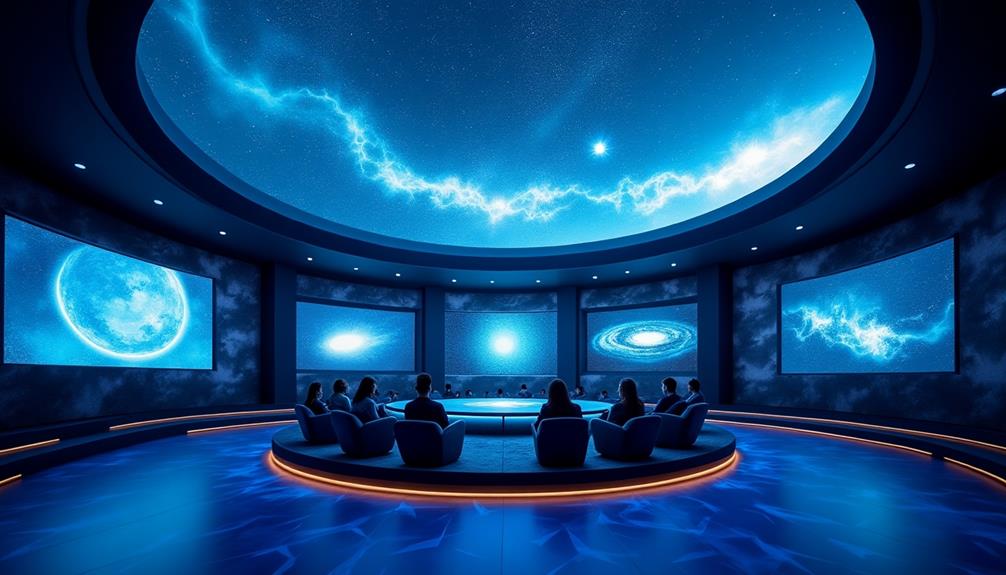Planetariums in Russia stand as important pillars of astronomical education and public engagement, with institutions like the Moscow Planetarium leading the charge. These venues not only provide immersive and technologically advanced experiences but also contribute greatly to the promotion of STEM fields. As centers for science communication, they are pivotal in enhancing scientific literacy across diverse populations.

Across Russia, planetariums serve as essential centers for astronomical education and public engagement, fostering a deeper understanding of the cosmos.
In the domain of scientific outreach, planetariums play an instrumental role in demystifying the complexities of astronomy and science for the public. They serve as pivotal centers for astronomy outreach, bridging the gap between intricate celestial phenomena and accessible knowledge.
Through immersive displays and interactive exhibits, planetariums foster science engagement, enhancing public interest in astronomical sciences. Educational initiatives within these institutions often include specialized youth programs, targeting the younger demographic to kindle curiosity and inspire future scientific endeavors.
The Moscow Planetarium
The Moscow Planetarium, one of the oldest and most significant in Russia, opened its doors to the public in 1929, serving as a pioneering institution for astronomical education and research.
Its historical significance is underscored by its early role in advancing public engagement with celestial phenomena. Through technological advancements, the planetarium facilitated educational outreach, bridging complex astronomical concepts with accessible presentations.
Its cultural impact was profound; it became a hub for fostering scientific curiosity and literacy among the Soviet populace. By integrating cutting-edge projection systems, the planetarium provided an unparalleled immersive experience, enhancing understanding of the universe.
The institution played a vital role in disseminating astronomical knowledge, reflecting a commitment to education that resonated far beyond Russia’s borders.
Through meticulously curated programs and exhibits, it engaged audiences with the wonders of the universe, thereby cultivating a deeper understanding of celestial mechanics and cosmic phenomena.
Moscow Planetarium’s Architecture and Technology
Amidst the burgeoning interest in celestial exploration during the early 20th century, the architectural design and technological innovations of the Moscow Planetarium stood as a demonstration to avant-garde engineering and scientific progress.
The planetarium’s structure, emblematic of Soviet architecture, incorporated design influences from Constructivism, emphasizing functionalism and simplicity. The dome, a key feature, allowed for immersive astronomical presentations, engineered with modern technology to project stellar phenomena accurately.
Few institutions demonstrate the dynamic interplay between architecture and science as profoundly as the Moscow Planetarium, whose development over the years reflects significant advancements in both fields.
Originally constructed in 1929, the planetarium’s architecture was a pioneering feat, integrating astronomical functionality with avant-garde design. Over time, its infrastructure has evolved to accommodate cutting-edge technology, enhancing its role in astronomy education.
The planetarium has become a focal point for public engagement, using outreach programs to cultivate scientific curiosity and understanding among diverse audiences. Its cultural significance as a hub for astronomical exploration underscores its commitment to fostering a connection between the cosmos and society.
The architectural and technological advancements of the Moscow Planetarium have laid the groundwork for a significant expansion in its educational offerings.
This expansion is characterized by an increase in lecture diversity, thereby accommodating a wide range of scientific topics tailored to various audience demographics. The planetarium’s commitment to program accessibility guarantees that these lectures are available to a broader public, enhancing audience engagement.
By integrating these offerings into educational curricula, the planetarium fosters a deeper understanding of astronomy and related sciences within academic settings.

Major renovations between 1994 and 2004
Between 1994 and 2004, the Moscow Planetarium underwent significant renovations that transformed its infrastructure and technological capabilities. These upgrades greatly enhanced both the physical space and educational offerings of the institution. The introduction of cutting-edge technology improved visitor engagement through advanced projection systems and interactive exhibits, creating a more immersive educational experience.
Despite these advancements, securing adequate funding posed challenges. Financial investments were essential to support the planetarium’s modernization while maintaining its operations.
Today, the Moscow Planetarium serves as a hub for astronomical exploration, blending scientific rigor with public engagement. It provides a platform for space enthusiasts and features state-of-the-art technology that enriches interactive learning experiences.
The planetarium’s educational outreach initiatives are designed to deepen understanding of astronomical phenomena, catering to diverse audiences to ensure accessibility in scientific education. Technologies like virtual reality simulations and digital exhibitions allow visitors to explore the cosmos in engaging ways.
The commitment to interactive learning is evident in hands-on workshops and lectures that stimulate curiosity and facilitate a comprehensive understanding of complex astronomical concepts. This approach underscores the institution’s role in promoting scientific literacy.
Among its notable features is the Large Star Hall, dedicated to showcasing astronomical phenomena through advanced technology. Central to this space is the Universarium M9 projector, renowned for delivering an immersive experience that captivates audiences by simulating celestial wonders with remarkable precision.
The Star Hall’s dome serves as a vast canvas for high-definition projections, enveloping viewers in a stellar atmosphere. This setup not only inspires awe but also serves as an effective educational tool, transforming complex concepts into accessible visual narratives that enhance visitors’ understanding of the cosmos.Utilizing a variety of interactive exhibits, workshops, and educational programs, the Moscow Planetarium engages visitors of all ages in understanding astronomical science. Its displays illuminate complex celestial phenomena, providing hands-on learning experiences.Community workshops foster a deeper appreciation for the cosmos among diverse audiences, while science fairs encourage youth engagement and exploration of scientific inquiry. By integrating technical insights with experiential learning, these programs inspire participants and ensure a robust educational journey.
Other Notable Planetariums in Russia

In addition to the Moscow Planetarium, Russia boasts other significant astronomical centers, such as the Planetarium 1 in Saint Petersburg, which holds the distinction of being the world’s largest, having opened in 2017.
This facility is remarkable for its innovative SpaceLab and a wide array of events designed to engage and educate the public.
Another key institution is the Kazan Federal University Planetarium, renowned for its advanced technological capabilities, which place it among the most sophisticated planetariums in the nation.
Located in the heart of Saint Petersburg, Planetarium 1 stands as an iconic institution dedicated to the dissemination of astronomical knowledge and the promotion of space sciences in Russia.
This venerable establishment serves as a beacon for star gazing enthusiasts and offers a robust platform for science outreach. It holds a revered place in the city’s cultural heritage, bridging the gap between historical scientific inquiry and contemporary astronomical events.
The planetarium hosts a myriad of stellar programs, designed to engage diverse audiences with the wonders of the cosmos. Through meticulously curated exhibitions and presentations, Planetarium 1 has become instrumental in fostering a deeper understanding of celestial phenomena, thereby contributing considerably to the scientific literacy of the community it serves.
Kazan Federal University Planetarium
The Kazan Federal University Planetarium, one of the distinguished astronomical centers in Russia, exemplifies the integration of scientific rigor and educational outreach.
With roots tracing back to the Kazan Observatory history, this planetarium has evolved into a hub for Astronomy outreach programs, greatly impacting both academic circles and the general public.
Nestled within the Astro Park, the integration of the historical Kazan Observatory with modern planetarium facilities exemplifies a seamless fusion of tradition and innovation in astronomical research and education.
This historical integration enhances the observatory’s legacy, dating back to 1837, by incorporating advanced astronomical technologies, fostering both scientific investigation and public engagement.
The Kazan Observatory serves as a cornerstone for science outreach, offering educational programs that connect the community with the cosmos.
Through interactive exhibits and cutting-edge digital projections, the Astro Park facilitates an immersive learning environment.
Community engagement is central, with initiatives designed to inspire curiosity and promote understanding of complex astronomical phenomena.
This synergy of historical and contemporary elements underscores the essential role of the Kazan Observatory within the Astro Park.
The Educational Power of Planetariums
Planetariums in Russia play a pivotal role in the popularization of astronomy by fostering scientific curiosity and engagement among youth through targeted educational programs.
These institutions offer a plethora of events and workshops designed to engage both school groups and families, effectively bridging the gap between academic science and public understanding.
Planetariums in Russia actively participate in science festivals, showcasing the wonders of the universe and promoting cosmic education.
By providing extensive educational resources, they empower audiences to grasp the intricacies of space science.
These centers utilize advanced technologies to simulate astronomical events, enhancing the learning experience and making abstract ideas tangible.
Acting as a bridge between public engagement and scientific education, Russian planetariums serve as essential platforms for stimulating youthful interest in science.
Through dedicated youth programs, these institutions employ interactive learning techniques that captivate and educate. By leveraging astronomy outreach, planetariums offer immersive experiences that transform abstract scientific concepts into tangible realities. This method of science engagement fosters a deeper understanding and appreciation of the cosmos among young audiences.
Additionally, community initiatives within planetariums create inclusive environments that encourage curiosity and critical thinking. By participating in these initiatives, youth are not only exposed to the wonders of the universe but are also inspired to pursue scientific inquiries.
With their unique ability to simulate celestial phenomena, Russian planetariums offer educational programs meticulously designed to engage schools and families.
These outreach programs are pivotal in enhancing scientific literacy through interactive lessons that elucidate complex astronomical concepts. By offering family workshops, planetariums provide a collaborative learning environment where parents and children can explore the cosmos together, fostering intergenerational curiosity and understanding.
Additionally, planetariums frequently participate in science fairs, showcasing cutting-edge astronomy research and technology. They also support astronomy clubs, providing resources and expertise to nurture young enthusiasts’ passion for celestial exploration.
Technological Innovations in Russian Planetariums

Russian planetariums are at the forefront of astronomical education through their adoption of cutting-edge projection technologies, which include digital full-dome systems capable of rendering high-resolution, immersive visual experiences.
These advancements are complemented by interactive exhibits and hands-on learning modules, designed to engage visitors and facilitate a deeper understanding of cosmic phenomena.
In recent years, the evolution of projection technology in Russian planetariums has marked a significant leap forward, enhancing both the educational and experiential aspects of astronomical presentations.
The integration of digital planetarium experiences has revolutionized how audiences engage with celestial phenomena. Immersive astronomy simulations now offer an unprecedented depth of understanding, utilizing advanced projection techniques to create realistic depictions of the cosmos.
Additionally, virtual reality stargazing has become a pivotal tool in offering users a unique perspective of the universe, enabling exploration beyond traditional boundaries.
Interactive exhibits and hands-on learning experiences are essential in enhancing the educational impact of planetariums in Russia. By integrating interactive technology, these institutions foster deeper science engagement and extend their educational outreach.
The utilization of digital interfaces and augmented reality applications allows visitors to explore astronomical phenomena in an immersive manner, promoting an engaging and informative experience.
Through community collaboration, planetariums incorporate local cultural and scientific interests, making learning relevant and accessible. Such initiatives not only make complex scientific concepts more tangible but also enhance cognitive retention among visitors.
Without a doubt, the integration of planetariums into the educational framework in Russia has greatly enhanced the scientific literacy of students and the general public.
Through strategic science outreach initiatives, planetariums have become instrumental in fostering educational partnerships and community programs. By hosting public lectures and facilitating youth engagement, these institutions provide an interactive platform for disseminating complex astronomical concepts.
The symbiotic relationship between planetariums and schools has resulted in curriculum enrichment and heightened interest in scientific careers. Additionally, planetariums serve as a nexus for interdisciplinary collaboration, blending art, technology, and astronomy.
Science advocacy within these institutions fosters a deeper understanding of the cosmos, nurturing critical thinking and analytical skills essential for scientific inquiry. Furthermore, community outreach programs extend the reach of planetariums, integrating diverse audiences and encouraging inclusivity in the scientific community.




